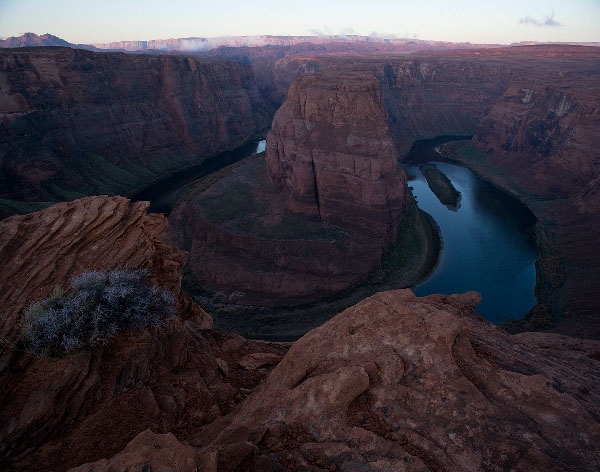
|
What do you do ?
Introduction by Alain Briot
Essay and Photographs by Jeff Ball
Other essays in this series
Introduction by Alain Briot
In this essay Jeff Ball continues the reflection he started in his previous essay Two and Three-Quarter Years. I considered publishing the two essays as a single piece, because they are about the same location, but decided not to because they are about different aspects of photography.
While both essays are about seeing Horseshoe Bend, What do you do? is also about the modifications that Jeff made to his images. In that respect this second essay addresses the area of manipulation or enhancement, depending on how you like to call it. There is a dividing line in that respect among photographers, some having decided to not alter their photographs in any way, while others, like myself, make no secret that enhancement is part of our workflow. I detail my approach in several essays, the most notable being Just say Yes which is available in ebook format here.
Essay by Jeff Ball
What do you do?
This is a very common question I receive from customers and I thought the following examples best exemplify what I do to take an image from initial visualization at the time of capture to the final optimized print. Interpretation has always been a part of photography. The interpretation was either by the camera gear selected (camera/film/filters/etc) or in the darkroom (paper selection/light source/filters/burning/dodging/montage) at the time of the print. It is no different today with digital technologies. One major difference is the amount of control one has in color photography has greatly increased with the development of digital technologies compared to past methods of color printing (dye transfer/c41/cibachrome).
The scene captured below in RAW format is certainly not the way I recall the scene either literally or interpretively. I have always envisioned a softer contrast to the scene. The swirls and linear patterns in the rocks are a major part of the scene. You can't help but notice the stair-stepped patterns in the rock layers as you walk around the overlook. So one of the major compositional considerations was to include the details of the nearby rock patterns into the overall majesty of the river bend. I also need to interpret the level of contrast in the overall scene as well as local contrast in individually separate areas of the scene.

Horseshoe Bend - November 2006
Raw Images stitched with Photoshop CS3 Beta
Canon 5D with 24mm tilt/shift for a 3 frame panoramic vertical stitch
The RAW conversion is where the initial "post visualization" takes place. The software used is Adobe LightRoom and there are about 10 individual controls that I utilize in RAW conversion to begin realizing my initial visualization. The controls used in RAW conversion are more "global" in that they influence the entire image with no regard for local control. Photoshop provides additional control over local areas by utilizing "masking" techniques. The time-line for all of this work can range from 4 days to several weeks. This particular image has taken over one week to optimize.
I often let images "stew" on the stove so to speak, revisiting them over extended periods of time to allow for a "visual recalibration" of sorts. It is not recommended to complete an image in one or two sessions. One must "cleanse the palate" in order for the image to be optimized without bias. These biases can happen as the result of viewing other images with high contrast, low contrast, different color palates, different color saturation, and so forth. Your eyes can become "attuned" to these biases and it will influence the enhancements you are making on the image at hand and may not lead to an optimized image for that particular lighting condition and scene. Right now you are being influenced in your interpretation of the two photos below by looking at the two side-by-side. The final image may look "flat" compared to the darker RAW stitch. It is best to view the final image by itself below where the final framed presentation is simulated.

Horseshoe Bend - March 2006
Fully optimized image with RAW conversion in Adobe Light Room and optimization in Photoshop CS2 and CS3 beta
Canon 5D with 24mm tilt/shift for a 3 frame panoramic vertical stitch
This image also represents one of my first examples of a "near-far composition" captured by utilizing a tilt/shift lens in a panoramic stitch configuration. I am not going to go into detail about the technique, but it is very powerful for increasing the resolution of a scene as well as maintaining sharp focus throughout the entire image while utilizing optimal focal ratios.
If you have any questions about the image or how to optimize your own images, please drop me an email or phone call. It is a wonderful time to be in photography and the learning never stops. I encourage you to develop your own personal photographic style and continue to create new and exciting artwork. Thanks for your interest and best wishes on your individual photographic successes.
Jeff Ball
Introduction Copyright © Alain Briot 2007
Essay and photographs Copyright © Jeff Ball 2007
All rights reserved worldwide
.
|
 |
|
|
|
|